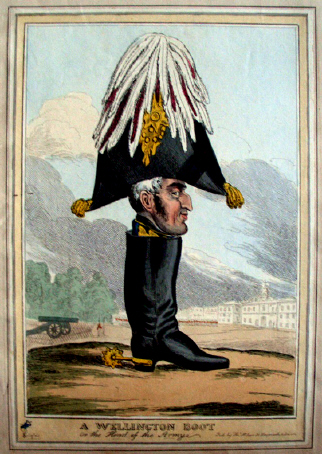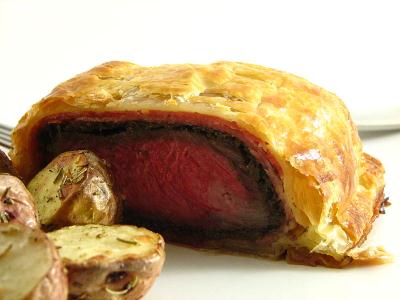

|
 Beef Wellington is a type of Beef Joint Pasty, made with a whole meat piece in pastry, rather than the chopped meat of the much more popular Cornish-type Pasty. England has a particular tradition of these joint pasties going back at least to the 17th Century and always made with rich spicings and served with a wine sauce. See, for instance, the original 1672 receipt 'To make a Pasty of a Breast of Veal' in 'The Queene-Like Closet' by Hannah Woolley The Wellington version consists of a whole fillet of beef wrapped in, or on a bed of, pâte de foie gras and/or mushrooms (possibly with Madeira or Cognac), rolled in a shortcrust (or flaky or puff) casing, glazed and baked. Served with a Madeira sauce.  The Duke of Wellington The name is assumed to be a homage to the great Irish general of the British Army and later Prime Minister, Arthur Wellesley, 1st Duke of Wellington (1769–1852), the hero of the Battle of Waterloo. Possible origins which have been suggested for the name include: ●Wellington the soldier had no concern at all for what food he was served and so allowed his cook to indulge his own fancies, of which this is one. ●Wellington loved this dish so much it had to be served at every dinner. ●The name arose because its form resembles the Wellington boot. ●The dish is of central African origin, traditionally using goat meat, and was discovered by Wellington when he served there (he never did). ●The dish is actually French, but re-named during the 19th Century wars with France. But Beef Wellington does not appear in any English cookbook we can find before about 1970, and we can't find it mentioned in literature before Michael Bond's 'Paddington Takes the Test' of 1981. It has no known connection, other than the name, with the Duke of Wellington or with the towns of Wellington in Cumbria. Herefordshire, Shropshire, Somerset or New Zealand. In fact this dish, so often seen as thoroughly English and completely Victorian, appears to be modern, originally French and named in America after an Irishman. There is a record of a 'Wellington Sauce' for service with beef at the Wellington Hotel in Gloucester (Exeter & Plymouth Gazette, 5 August 1926), but other than that all the earliest references to BW are from the USA, and relatively modern. Amongst them there is mention of 'Fillet of beef, a la Wellington' in the Los Angeles Times of October 28, 1903, but this seems to refer to beef with chutney. Dinaa Ashley's 1939 guide to New York City restaurants 'Where to dine in '39' refers to "Tenderloin of Beef Wellington. Larded tenderloin of beef. Roast very rare. Allow to cool and roll into pie crust. Slice in portions and serve with sauce Madire." (OED). It rather looks as if BW, as we now know it, was first made famous by the American TV cook Julia Child, whose book 'Mastering the Art of French Cooking' was immensely popular in the USA. She certainly presented a version of the well-known French filet de bœuf en croûte ('fillet of beef in crust'), which she entitled 'Filet of Beef Wellington' on TV in her 'The French Chef ' series broadcast on New Year's Day 1965, after which BW seems to have become hugely popular in North American social circles and was repeated in a large number of magazines and cookbooks, including the very influential 'White House Cookbook'. To Americans, unaccustomed to the idea of meat in pastry, strangers to the English idea of pies and to whom the Pasty is unknown, Beef Wellington must have seemed a quite exotic dish.  A Beef Wellington, cut Image: Parkerman & Christie, San Diego, USA  Original Receipt in Julia Child's 'Mastering the Art of French Cooking' Original Receipt in Julia Child's 'Mastering the Art of French Cooking'Beef Wellington For the Beef Marinade part : 1/3 cup olive oil 1/2 cup sliced onion 1/2 cup carrot 1/2 cup celery 1/4 teaspoon dried thyme 1/4 teaspoon sage 1 bay leaf 3 allspice berries or cloves 6 peppercorns 1 teaspoon salt 1 cup dry white vermouth 1/3 cup cognac or brandy For the Mushroom Duxelles part : 2 lbs mushrooms 2 tablespoons butter 4 tablespoons shallots, minced 1/2 cup dry madeira wine 4-5 tablespoons mousse type pate or foie gras 4 (8 ounce) filet of beef 4 slices prosciutto, thin 2 sheets puff pastry For the Madeira Sauce part : 2 cups beef broth 1 tablespoon tomato paste 2 tablespoons cornstarch 1/4 cup Madeira wine DIRECTIONS : 1 Place all marinade ingredients (except salt, vermouth and cognac) in a small saucepan. 2 Cook slowly until vegetables are tender. 3 Remove from heat and let cool. 4 Season filets with salt; place in ziplock bag; add marinade mixture; pour on the wine and cognac. 5 Refrigerate 2 to 3 hours. 6 Remove from marinade. 7 Pat dry. 8 Heat 1 T oil in a heavy duty saute pan over high heat. 9 Add filet and sear briefly on all sides. 10 Return to refrigerator until ready to assemble the Wellingtons. 11 Reserve marinade for sauce. 12 Mince mushrooms in food processor until very small. 13 In the corner of a clean kitchen towel, twist the mushrooms a handful at a time to extract as much of the mushroom juices as possible. 14 I usually dampen the towel first so it won’t absorb the juices of the mushrooms. 15 Reserve the juices for the sauce. 16 Saute mushrooms and shallots in butter 7 or 8 minutes or so until the mushroom pieces separate from each other and begin to look dry. 17 Add the madeira and boil until liquid has evaporated. 18 Season to taste and stir in the pate or foie gras. 19 Simmer marinade ingredients and mushroom juices with 2 cups beef broth and 1 T tomato paste for 1 hour or so until reduced to 2 cups. 20 Degrease, season and thicken with 2 Tbs. 21 cornstarch mixed with 1/4 cup Madeira. 22 All of these steps can be prepared well in advance and even frozen in separate containers. 23 Simply thaw everything before proceeding. 24 I usually get two Wellingtons out of each sheet of puff pastry. 25 It depends on the size of the steaks. 26 Roll out each sheet a little to accomodate the size of the filet. 27 Cut sheet in half. 28 Lay one sheet of Prosciutto on each half. 29 Place a spoonful of mushrooms on top; place a filet on top of mushrooms; spoon a little more mushrooms on top of filet; wrap filet in pastry. 30 Pinch to seal. 31 If you have any pastry left over, be creative and decorate the Wellingtons to fit the occasion. 32 Place on parchment lined cookie sheet. 33 Refrigerate at least 30 minutes or until ready to bake. 34 Preheat oven to 375F. 35 Egg wash the tops of the Wellingtons. 36 Bake until golden brown. 37 About 25 minutes. 38 Use an instant read thermometer to insure that the meat is done to your liking. 39 If Wellingtons start to brown too much before the meat is ready, cover with foil and cook until it is done. 40 Serve with the Madeira sauce spooned on top.  |
|
MORE FROM Foods of England... Cookbooks ● Diary ● Index ● Magic Menu ● Random ● Really English? ● Timeline ● Donate ● English Service ● Food Map of England ● Lost Foods ● Accompaniments ● Biscuits ● Breads ● Cakes and Scones ● Cheeses ● Classic Meals ● Curry Dishes ● Dairy ● Drinks ● Egg Dishes ● Fish ● Fruit ● Fruits & Vegetables ● Game & Offal ● Meat & Meat Dishes ● Pastries and Pies ● Pot Meals ● Poultry ● Preserves & Jams ● Puddings & Sweets ● Sauces and Spicery ● Sausages ● Scones ● Soups ● Sweets and Toffee ● About ... ● Bookshop ● Email: editor@foodsofengland.co.uk COPYRIGHT and ALL RIGHTS RESERVED: © Glyn Hughes 2022 BUILT WITH WHIMBERRY |